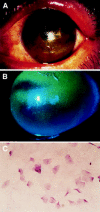Treatment of dry eye by autologous serum application in Sjögren's syndrome
- PMID: 10434857
- PMCID: PMC1723012
- DOI: 10.1136/bjo.83.4.390
Treatment of dry eye by autologous serum application in Sjögren's syndrome
Abstract
Aim: To evaluate the efficacy of autologous serum application for the treatment of dry eye in Sjögren's syndrome.
Methods: The stability of essential components (EGF, vitamin A, and TGF-beta) in preserved serum were examined following preservation at 4 degrees C and -20 degrees C. In a primary clinical trial, 12 patients with Sjögren's syndrome were treated with autologous serum (diluted to 20% with sterile saline) for 4 weeks, and vital staining of the ocular surface was compared before and after treatment. The effects of serum on mucin (MUC-1) expression were observed in cultured conjunctival epithelial cells in vitro.
Results: EGF, vitamin A, and TGF-beta were well preserved for up to 1 month in the refrigerator at 4 degrees C and up to 3 months in the freezer at -20 degrees C. Rose bengal and fluorescein scores improved significantly from the initial scores of 5.3 and 5.6 to 1.7 and 2.5 after 4 weeks, respectively. The additive effect of human serum for cultured conjunctival epithelial cells showed significant MUC-1 upregulation on the cell surface.
Conclusion: Autologous serum application is a safe and efficient way to provide essential components to the ocular surface in the treatment of dry eye associated with Sjögren's syndrome.
Figures



Comment in
-
Much more than water.Br J Ophthalmol. 1999 Apr;83(4):384-5. doi: 10.1136/bjo.83.4.384. Br J Ophthalmol. 1999. PMID: 10434854 Free PMC article. No abstract available.
References
Publication types
MeSH terms
Substances
LinkOut - more resources
Full Text Sources
Other Literature Sources
Medical
Research Materials
Miscellaneous
